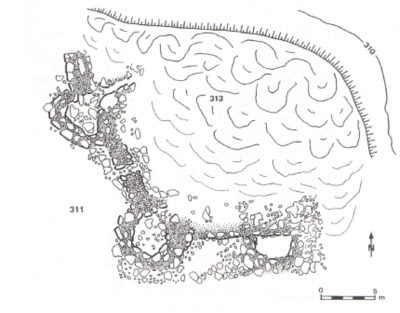Olelas plan, after Gonçalves, 1997.
Location: Sintra municipality, Lisbon, Estremadura, Central
Portugal.
Chronology: Chalcolithic
Bibliographic references: Serrão & Vicente, 1958; 1959; Gonçalves, 1997; Sousa, 2010.
Chronology: Chalcolithic
Bibliographic references: Serrão & Vicente, 1958; 1959; Gonçalves, 1997; Sousa, 2010.
The quite small Olelas walled enclosure is one of the most
interesting enclosures of the Portuguese Estremadura, although it is also one
of the most problematic regarding the quality of its information.
It was discovered in the XIX century, but the
excavation started only in the fifties of the XX century. Then, two circular
stone structures were identified and, based on the material, interpreted as
funerary monuments: they provide artifacts that were associated to the sacred
dimension of life and some human remains. But some stone walls between these
structures were also identified and that raised an ambiguous position of the
excavators between the settlement and the funerary interpretation, giving a
certain privilege to the symbolic and sacred side of the equation.
Later, in the late eighties/early nineties, new
excavations were developed there, a more complete plan published, some
radiocarbon dates obtained and the “fortified settlement” interpretation
established.
Since then, Olelas has been just so: a fortified
settlement, just like so many others in the region.
However, I think it would be interesting to come back
to Olelas with some new questions in mind, supported in different theoretical
backgrounds.
The material collected in Olelas shows at least two
previous moments of occupation before the wall was built. One from Early Neolithic
and another from Late Neolithic. The walls and the three circular structures (I
wander if they can be interpreted as Boussargues – see here) were presumably
built in the third millennium (the radiocarbon dating doesn’t specifically date
the construction of these structures), so we do not know exactly when they were
built. There are some decorated pottery of “folha de Ácacia” in small numbers
and more numerous assemblages of bell beaker pottery (Sousa, 2010). This means
that the walled structures and towers might have been built in a latter phase inside
Chalcolithic and not necessarily in the earlier phases of the millennium. I
mean, although we have previous occupations (even in Chalcolithic), the enclosure itself might be
relatively late.
It is a small enclosure, only of 0,1 ha, defined by
the wall structures and by a natural cliff (just like Liceia, but much, much
smaller). And it reminds me a lot Fraga da Pena, also defined by a wall with
bastions in one side and a natural feature by the other, also very, very small,
built in the late third millennium and also with a dominant beaker occupation. At
Olelas, the size, the presence of specific exceptional materials, the presence of
human remains, the preponderance of bell beaker pottery, and all of these taken in
relation suggests a context similar to Fraga da Pena, which clearly isn’t a
fortified village.
It is clear now in Portugal that enclosures were
diversified contexts, that they did not all perform the same social roles or respond all
to the same social needs. I suspect that the available poor information of
Olelas is telling us that this particular site cannot be just submitted to an
homology with other larger walled enclosures of the region. But it is just a suspicion,
based on the theoretical frames and empirical data that show the diversity of
these sites and their cosmological bonds.
The site should be revisited, but with new theoretical
frameworks that allow confrontation of a diversity of possible interpretations.


Deve ser um recinto calcolítico de altura com bastiões, tipo tão característico da Península e tão mal ainda investigado, sendo perniciosa a designação de "povoado fortificado" para este tipo de sítios, como sabemos, pois não só unifica tudo (o que é decerto diversificado...) sob uma terminologia funcional redutora, como induz métodos de pesquisa inadequados e até destruidores de informação...
ReplyDelete